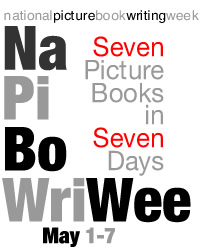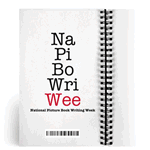NaPiBoWriWee 2011 Day Four – Good Morning!
Welcome to Day Four of the 2011 National Picture Book Writing Week!
OMG! We are HALFWAY THROUGH NaPiBoWriWee! Can you BELIEVE it?! 🙂
So as I’ve mentioned before, when I’m not writing or playing with my cats, I teach the craft of writing fiction! So now that we’ve explored first drafts, plot structure, and theme, let’s take a look at something called THE HERO’S JOURNEY. In other words… character. WHO are we writing about? What does our main character want? What’s getting in his/her way of reaching their goal?
You know how they say it’s not always the end that matters but the journey itself? Let’s explore this concept a little bit more this morning before we tackle Picture Book No. 4.
(Keep reading after the jump for more on THE HERO’S JOURNEY…)
THE HERO’S JOURNEY
The Hero’s Journey is a famous concept from Joseph Campbell’s The Hero With a Thousand Faces. It’s all about “the hero’s journey” in storytelling.
The book I have used when teaching my writing classes includes a more modern take on this classic concept. It’s The Writer’s Journey: Mythic Structure for Writers by Christopher Vogler (Michael Wiese Productions, 2nd Ed., 1998). This book does a great job of explaining the classic “The Hero With a Thousand Faces” by Joseph Campbell from a movie and storyteller’s perspective. Campbell’s book is about the “hero’s journey” in storytelling, and Vogler’s book is a classic screenwriter’s perspective on that concept.
Here are some excerpts below that explain more about the hero’s journey. I hope you find these helpful and inspirational as you brainstorm today’s picture book journey for your main character!
From The Writer’s Journey: Mythic Structure for Writers by Christopher Vogler (Michael Wiese Productions, 2nd Ed., 1998)
P. 13: “At heart, despite its infinite variety, the hero’s story is always a journey. A hero leaves her comfortable, ordinary surroundings to venture into a challenging, unfamiliar world. It may be an outward journey to an actual place: a labyrinth, forest or cave, a strange city or country, a new locale that becomes the arena for her conflict with antagonistic, challenging forces.
“But there are as many stories that take the hero on an inward journey, one of the mind, the heart, the spirit. In any good story the hero grows and changes, making a journey from one way of being to the next: from despair to hope, weakness to strength, folly to wisdom, love to hate, and back again. It’s these emotional journeys that hook an audience and make a story worth watching.”
P. 36: AUDIENCE IDENTIFICATION – “Heroes have qualities that we all can identify with and recognize in ourselves. They are propelled by universal drives that we can all understand: the desire to be loved and understood, to succeed, survive, be free, get revenge, right wrongs, or seek self-expression. Stories invite us to invest part of our personal identity in the Hero for the duration of the experience. In a sense we become the Hero for awhile. We project ourselves into the Hero’s psyche, and see the world through her eyes.
“Heroes should have universal qualities, emotions, and motivations that everyone has experience at one time or another: revenge, anger, lust, competition, territoriality, patriotism, idealism, cynicism or despair. But Heroes must also be unique human beings, rather than stereotypical creatures or tin gods without flaws or unpredictability… a well-rounded Hero can be determined, uncertain, charming, forgetful, impatient, and strong in body but weak at heart, all at the same time. It’s the particular combination of qualities that gives an audience the sense that the Hero is one of a kind, a real person rather than a type.”
P. 37: GROWTH: “The hero is the one who learns or grows the most in the course of the story. Heroes overcome obstacles and achieve goals, but they also gain new knowledge and wisdom.”
ACTION: “The Hero is usually the most active person… his will and desire is what drives most stories forward. A frequent flaw is that the Hero is fairly active throughout the story, but at the most critical moment becomes passive and is rescued by the timely arrival of some outside force. At this moment above all, a Hero should be fully active, in control of his own fate. The Hero should perform the decisive action of the story, the action that requires taking the most risk or responsibility.”
FLAWS: “Flaws also give a character somewhere to go – the so-called ‘character arc’ in which a character develops from condition A to condition Z through a series of steps. Flaws are a starting point of imperfection or incompleteness from which a character can grow. They may be deficiencies in a character. Perhaps a Hero has no romantic partner, and is looking for the ‘missing piece’ to compete her life. This is often symbolized in fairy tales by having the Hero experience a loss or death in the family… this subtraction of the family unit sets the nervous energy of the story in motion, not to stop until the balance has been restored by the creation of a new family or the reuniting of the old.”
VARIETIES: “Heroes come in many varieties, including willing and unwilling Heroes, group-oriented and loner Heroes, Anti-heroes, tragic heroes, and catalyst Heroes.”
######
Our NaPiBoWriWee Day Four schedule:
9 AM (PST): Good Morning Blog posted. I hope you enjoyed reading it. I look forward to your comments!
12 PM (PST): Guest Author Blog will be posted. Today’s guest? Picture book debut author TARA LAZAR! So stop by to hang out with the wonderful Tara!
10:00 PM (PST): Bedtime Blog will be posted. Stay tuned and please post your progress report in the Bedtime Blog comments section. I look forward to hearing about your Day 4 adventures!
Okay, that’s it from me. Until the next blog posting… Happy Writing! WRITE LIKE YOU MEAN IT! 🙂


I definitely agree that heroes come in many varieties as in Benjamin and Bumper to the Rescue. A lovely picture book written by Molly Coxe. But it really isn’t an endearing story if the characters don’t have flaws, is it? I mean we all have to grow in life. Even in books and a lot of times through books. I enjoyed this post. 🙂
Hi Robyn! I think that is an EXCELLENT point. Not all characters have to have “flaws.” But they have to CHANGE or GROW. So if they are not overcoming a flaw in their character, then they are growing from one stage to the next, such as a child learning how to crawl and explore, for example. Thanks for your thoughtful comment! 🙂
Lots to think about here. Writing a pb with a strong arc and an engaging mc that starts out flawed and overcomes an obstacle all in 32 pages, 1000 words of less, well, it’s a challenge, right? But that’s what this week is about!